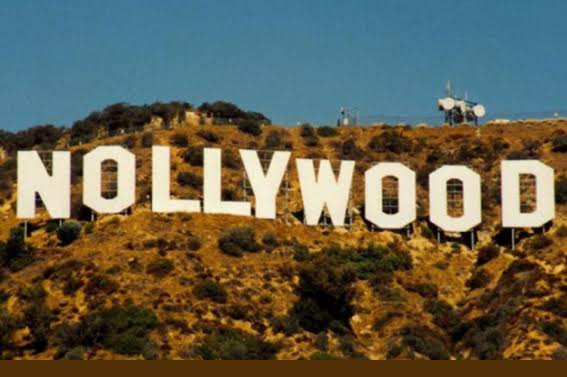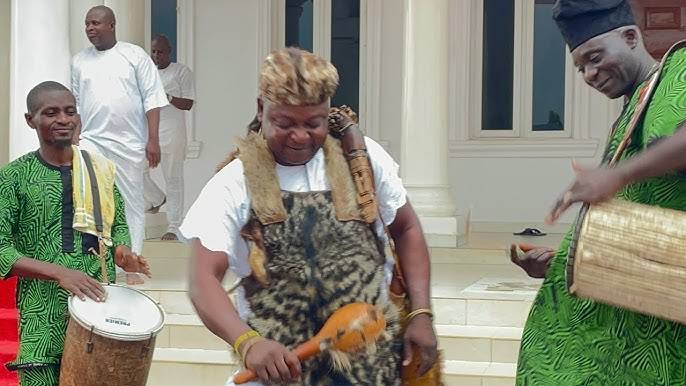In the late 1990s and early 2000s, as flickering images from Nigeria’s chaotic video film industry began spilling onto satellite screens across Africa, a single word started whispering its way into the cultural bloodstream: Nollywood. It did not arrive with ceremony, no decree nor bannered announcement.
Instead, it slipped quietly through magazine articles, foreign correspondents’ notebooks, whispered conversations among critics, and eventually the mouths of Nigerian filmmakers themselves. Yet, for a name so powerful—one that would become shorthand for Africa’s largest film industry—the question of who first called it Nollywood has never been conclusively settled. And like all disputed histories, the uncertainty has only deepened its mystery.
The word is now so natural, so embedded, that it feels as if it has always existed. But the reality is far more complicated. Its arrival sits at the intersection of journalism, cultural appropriation, postcolonial identity, and the hunger of an emerging industry for a unifying banner. To trace it is to untangle a web of conflicting claims, each offering a piece of the puzzle but none able to close the case entirely.
This is the long, twisting history of Nollywood’s baptism—a name contested, embraced, and redefined.
The Global Trend of “-wood” Cinemas
Before Nollywood, there was Hollywood in California—already synonymous with global stardom and mass entertainment by the 1920s. Then came Bollywood, India’s Mumbai-based juggernaut, its name coined by merging “Bombay” (now Mumbai) with “Hollywood.” By the late 20th century, attaching “-wood” had become an international shorthand for any booming film industry: Dhallywood in Bangladesh, Lollywood in Lahore, Gollywood in Ghana.
When Nigerian filmmakers began flooding markets with VHS tapes in the 1990s, the world sought a convenient label. To foreign observers, the “-wood” suffix was obvious; to Nigerians, it was a double-edged sword—simultaneously recognition and reduction.
The international media was already trained to categorize cinema in this way. The “-wood” naming scheme was shorthand, a neat journalistic device that flattened local complexity into something global audiences could digest. So, when Nigeria’s video boom demanded attention, the world instinctively reached for the familiar template.
Nigeria’s Video Boom: Fertile Ground for a Name
In the early 1990s, Nigeria’s cinema halls were crumbling under economic collapse, IMF austerity measures, and political instability. But something unexpected happened: a home video revolution. Cheap VHS tapes, pirated distribution channels, and handheld cameras democratized filmmaking. Suddenly, stories once told in living rooms, theatres, or on traveling stages were being recorded and sold in markets like Idumota in Lagos and Upper Iweka in Onitsha.
The production process was messy, almost anarchic. Films were shot in weeks, edited in back rooms, and duplicated in thousands of copies for street vendors. Themes ranged from melodramatic romances to moralistic Christian tales, village comedies, and supernatural thrillers. The quality varied wildly, but the appetite was insatiable. Audiences, starved of cinema halls, devoured these tapes. By the late 1990s, the industry was producing hundreds, even thousands of films annually.
International observers, baffled by the speed and sheer output, needed a convenient way to describe the phenomenon. That vacuum invited outsiders to supply one.
The New York Times Claim: Norimitsu Onishi’s Pen
One of the strongest claims traces the origin to Japanese Canadian Journalist, Norimitsu Onishi, a New York Times correspondent who, in 2002, published an article describing Nigeria’s booming video-film industry. In that piece, he reportedly used the word “Nollywood”, borrowing from Bollywood and Hollywood, to capture the chaotic scale and energy he witnessed.
For years, Onishi’s article has been cited as the definitive “birth certificate” of the word. His global platform meant that once the Times printed it, the term was effectively consecrated for international use. Nigerian scholars, Western critics, and festival curators began repeating it, cementing its association with Nigeria’s video-film explosion.
But here lies the twist: while Onishi amplified it, did he actually invent it—or merely echo something already circulating?
Earlier Echoes: Whispered Before Print
Before Onishi’s article, some insiders insist the word was already bouncing around Lagos production circles. Nigerian journalists, critics, and even marketers claim to have heard “Nollywood” in informal conversations in the late 1990s. Certain oral accounts suggest it was used offhand by a group of foreign correspondents in Lagos—an insider shorthand that slowly seeped outward. Others argue that Nigerian marketers, keen on branding their flood of video releases, coined it to boost legitimacy in a global marketplace dominated by Bollywood.
The absence of archival evidence complicates things. Nigeria’s film culture was largely undocumented at the time. Many articles, pamphlets, and magazines that might have preserved early uses of the word were lost in the churn of Lagos’s media chaos. Oral testimony hints at the possibility that Nollywood existed before 2002—unwritten, undocumented, but alive in conversation.
Without written proof, these claims hover in speculation. But they expose an important truth: the naming of Nollywood was not a singular, thunderclap invention but a gradual crystallization.
The Matt Steinglass Theory
Another claimant enters through Matt Steinglass, a journalist who in 2002 published in The Christian Science Monitor. Some argue he used the term around the same period as Onishi. For Steinglass, the word seemed a descriptive convenience, not a cultural manifesto. His framing leaned on comparison to Bollywood, suggesting Nigeria was catching up in sheer volume, if not production value.

This overlapping timeline complicates the question: was Nollywood coined independently by different journalists observing the same phenomenon? Did one borrow from the other? Or was the word already floating in the ether, ready for the first to print it? What matters is not just chronology but also diffusion—the article that reached the widest audience became the version of history that stuck.
Nigerian Voices: Acceptance and Resistance
Within Nigeria, the name was initially met with suspicion. To many filmmakers, it felt reductive—another Western framing imposed on Africa, lumping a diverse cinematic tradition into a Hollywood mimicry. Filmmakers like Tunde Kelani, rooted in Yoruba theatre and deep cultural aesthetics, resisted the label. They argued that Nigeria’s cinema was not an imitation but an evolution of indigenous storytelling traditions, from stage plays to traveling troupes.
Others, especially marketers and younger producers, embraced it as a passport to legitimacy. For them, Nollywood was branding gold. It made Nigerian films easier to market abroad, easier to categorize at festivals, and easier to pitch to investors. By the mid-2000s, “Nollywood” had taken root. Film festivals, academic papers, and government agencies adopted it, whether out of convenience or pride. The debate over who coined it began to matter less than the fact that the world now recognized it.
Nollywood Before Nollywood: Indigenous Naming Traditions
It is important to note that before the Western “-wood” stamp, Nigeria already had robust naming traditions for its performing arts. The Yoruba traveling theatre was sometimes called “Alarinjo.” The Hausa film industry in Kano had long called itself Kannywood (though this came later in formal branding). The Igbo film market at Onitsha was simply known as the “video market.”
Had Nigeria named itself, perhaps it would have chosen differently. Names rooted in local languages, mythologies, or markets might have carried different weight. But history shows that external observation often provides the sticky label, even when insiders later claim ownership. What mattered was not authenticity but resonance.
Why the Name Stuck
Despite its contested origin, “Nollywood” stuck for several reasons:
1. Global Branding Power – The Hollywood suffix carried weight internationally. Foreign journalists, scholars, and distributors found it easy shorthand.
2. National Pride – Over time, Nigerians embraced the name, reframing it as a badge of identity rather than a foreign imposition.
3. Marketability – International festivals, investors, and audiences needed a single label to grasp the chaotic abundance of Nigeria’s film output.
Like nicknames given in childhood, Nollywood survived because it resonated, not necessarily because it was accurate. It had rhythm, it had recall, and it placed Nigeria instantly in a global conversation about cinema.
The Digital Age: Nollywood Beyond VHS
As the industry transitioned from VHS to VCDs, then to streaming platforms like iROKOtv and Netflix, the name’s reach expanded. By the 2010s, Nollywood was a global keyword. Search engines, film catalogues, and cultural critics used it without question. What began as a disputed coinage had transformed into an undisputed brand.
Today, Nollywood headlines international festivals, university syllabi, and global cinema debates. Its filmmakers win awards in Toronto, Berlin, and Venice. Its stars trend on Netflix in São Paulo and Johannesburg. The name, once contested, is now inseparable from the identity of the industry.
How International Media Coverage Shaped Nollywood’s Perception Abroad
Global media outlets, including the BBC, Al Jazeera, and CNN, amplified the term. Academic studies and film festival coverage further entrenched the label. The repetition in international discourse helped normalize the term, even among Nigerian filmmakers who were initially skeptical. Beyond simple reporting, these outlets framed Nollywood as a cultural and economic phenomenon, emphasizing its uniqueness as an indigenous video film industry that rivaled the output of more established cinemas. Feature articles often highlighted the rapid production cycles, grassroots distribution methods, and the vibrant storytelling that characterized Nigerian films, casting them as emblematic of a new era of African creativity.

The international spotlight also brought attention to the industry’s challenges—low budgets, piracy, and infrastructural limitations—which paradoxically enhanced its narrative appeal. Coverage painted Nollywood as an underdog industry, resilient and resourceful, inspiring both admiration and curiosity. The global press created a feedback loop: international interest legitimized local acceptance, and local filmmakers began engaging more directly with foreign journalists to control the narrative around the term.
Filmmakers Reflect on Nollywood: Pride, Resistance, and Creative Ownership
Filmmakers’ perspectives evolved over time. Initial resistance gave way to acceptance as Nollywood became synonymous with both economic opportunity and cultural influence. Directors and producers began using the label strategically, recognizing its value in marketing, festival circuits, and international recognition. For many, embracing the term meant securing access to funding, distribution, and collaboration opportunities with international platforms. It was no longer merely a name—it became a passport to global markets.
This evolution also reflected a generational shift. Younger filmmakers, growing up amidst the video boom, were more willing to align themselves with the Nollywood brand. They viewed it as a symbol of modern Nigerian identity, a way to showcase local stories on a global stage. Older industry veterans, while initially wary of the label’s Western origins, gradually appreciated its ability to attract attention and respect for Nigeria’s cinematic achievements.
Film Festivals and the Global Cementing of the Nollywood Brand
Film festivals played a pivotal role in legitimizing Nollywood. Events like the Pan African Film Festival in Los Angeles and the Africa International Film Festival in Lagos provided platforms for Nigerian films and reinforced the term in the global consciousness. Festival programs, catalogs, and panels consistently used the term, solidifying its usage. These events also allowed filmmakers to network with international producers, distributors, and critics, further enhancing the visibility of Nollywood productions.
Participation in international festivals helped Nigerian films gain critical acclaim, moving beyond purely commercial success. Awards, panel discussions, and curated screenings showcased the depth and variety of Nollywood storytelling, dispelling early misconceptions about the industry being low-quality or formulaic. Over time, festival recognition elevated Nollywood from a niche curiosity to a serious subject of global cinematic discourse.
Symbolism of the Dispute
The fight over who coined “Nollywood” is more than pedantic. It reflects deeper tensions: Who has the right to name African cultural industries? Whose language legitimizes? And how does a people take back ownership of a name once it has been given?
For Nigerians, Nollywood is no longer just a borrowed suffix—it is a redefinition. In its films, messy and brilliant, raw and polished, lies a distinctly Nigerian cinematic voice. The word has outgrown its contested roots. Nollywood, once a journalistic shorthand, has become an emblem of cultural pride.
Conclusion: A Name Larger Than Its Birth
The disputed history of Nollywood’s naming tells us that sometimes, identity is forged not by a single hand but by many voices colliding. Whether it was Onishi’s pen, Steinglass’ article, a Lagos journalist’s quip, or a marketer’s pitch, the truth is that Nollywood was never just a label. It was a mirror of Nigeria’s ability to transform fragments into wholeness, improvisation into permanence.
Today, Nollywood stands not as a question of who named it, but as a testament to what Nigeria’s storytellers built. The name may remain contested, but its power is uncontested.




